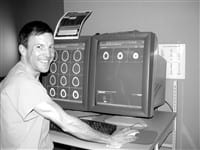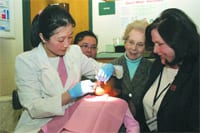From Hard Copy To Hard Drive Mercy’s New Imaging Technology Improves Storing And Sharing Of Records
It’s a common accident — a child falls off a swingset and is rushed to the emergency room, where her injuries require X-rays and other diagnostic imaging tests.
But at Mercy Medical Center, what happens once those images are taken is anything but common.
Assume for a moment that the girl’s images appear on a computer workstation and a radiologist identifies what might be life-threatening skull injuries. With the help of the new Picture Archiving and Communication System (PACS), that radiologist can alert a surgeon in another part of the hospital, or even at home, and they can simultaneously view the pictures to determine the best course of action.
“The most important thing PACS does is allow us to share images with clinicians instantaneously,” said Dr. Steve Allen, Mercy’s chief of Radiology. “Images and reports are available as soon as they’re taken.”
And that’s not all. Not only does the equipment, developed by GE Medical Systems Information Technology, change the way X-rays, CT scans, and MRI scans are communicated, it also revolutionizes the way they are managed and stored.
“In the old days, we would take images and store the film as part of the patient’s permanent record,” Allen said. “And those pieces of film could be damaged by water, lost, misplaced, or misfiled, and all of those things result in us not being able to render a good diagnosis. Now, instead of storing them on film, we can store them as ones and zeros on a gigantic hard drive — and when I say gigantic, I mean in the terabyte range.”
As he told The Healthcare News, the $1 million cost of taking PACS system-wide will be offset somewhat by savings in film and processing costs, but money isn’t the driving factor behind obtaining the technology — the emphasis is on improving patient care.
Check It Out
The PACS equipment combines state-of-the-art digital imaging with computerized process automation workflow software, digital image storage, and far-reaching, high-performance networking technology. Images may be viewed by authorized hospital staff on any PC on the Mercy network, at any time of the day or night.
Patient privacy is a key issue in health care these days, and security and patient confidentiality are guaranteed through controlled user accounts on the secured system. At the same time, PACS allows rapid distribution and access to images and reports to the professionals who need to see them.
“To open a patient’s images, I go to the browser, and everything we’ve done is there. I double-click on them, and the images appear,” Allen said.
Voice-recognition (VR) dictation software has also been deployed in conjunction with PACS to further enhance information exchange speed and productivity. VR software instantly converts spoken works into typed text on a computer screen and eliminates the traditional delays associated with manual transcription processes, enabling rapid distribution of exam results as well as the images themselves.
“A physician could be in his office looking at the CT scan image of a liver, asking me, ‘what do you think of that?’” Allen noted. “I can have the same image in front of me and say, ‘that’s hemangioma,’ or, ‘I don’t know — let’s see what his other studies show.’”
Mercy administrators call PACS a natural next step in imaging technology after Mercy became the first Western Mass. hospital to offer LightSpeed CT equipment last summer. The addition of PACS, they say, will allow the hospital to share radiology information as well as extend its expertise across the region and state.
“It’s enterprise-wide,” Allen said. “Everything from mammography to nuclear medicine is on the PACS system — every X-ray, every mammogram, everything.
“The efficiency is really great,” he added. “Technologists used to spend a significant amount of time developing images — even a fast processor takes a minute and a half to two minutes generating an image. Now, it’s up on the screen instantaneously. They verify it, and it’s available for us to read.”
Weight Control
And by speeding up the work of the radiologists and technologists, Allen said, PACS is increasing their productivity — which in turn enhances patient care.
“This really is the future of medical imaging,” Allen said. “Now, it’s not unusual for us to have a study with 1,000 images, and you can imagine how quickly that becomes a jacket you can’t even lift. Someone in the hospital with a lot of complicated problems can easily have eight or 10 jackets filled with that heavy X-ray film.”
Thanks to PACS, the pictures in those heavy jackets are now just a mouse click away. That’s a weight off everyone’s shoulders — physicians, radiologists, and, in the end, patients.



